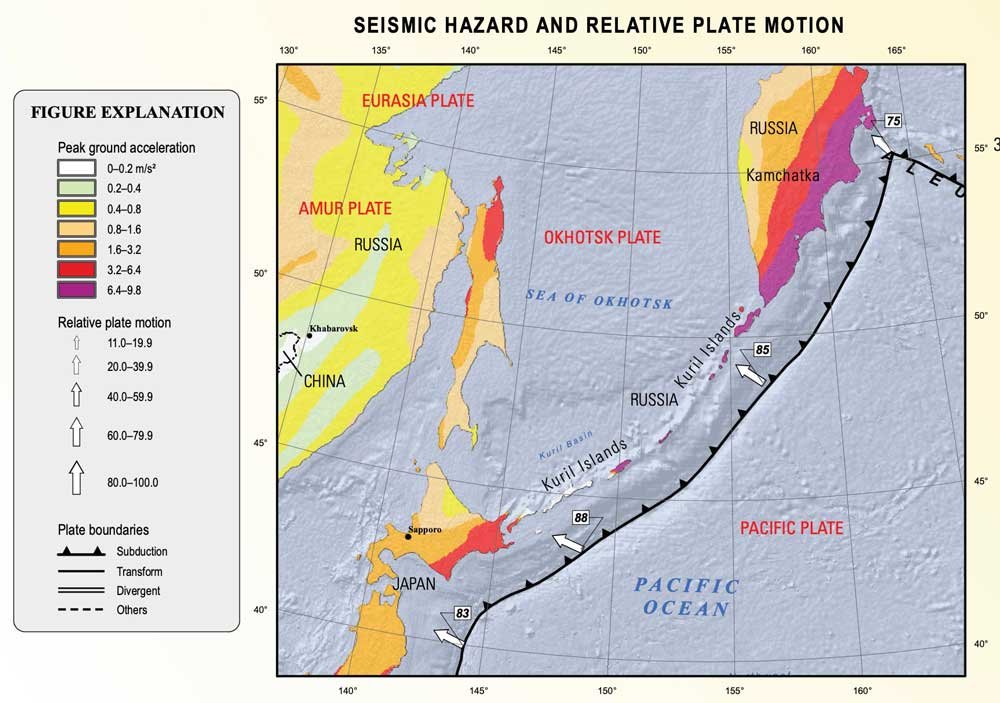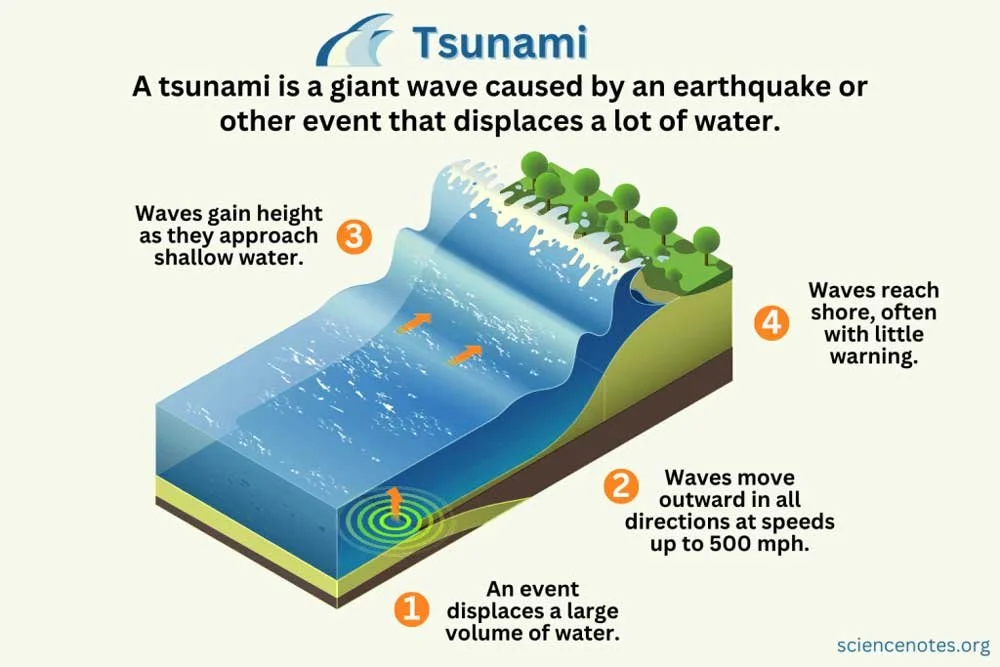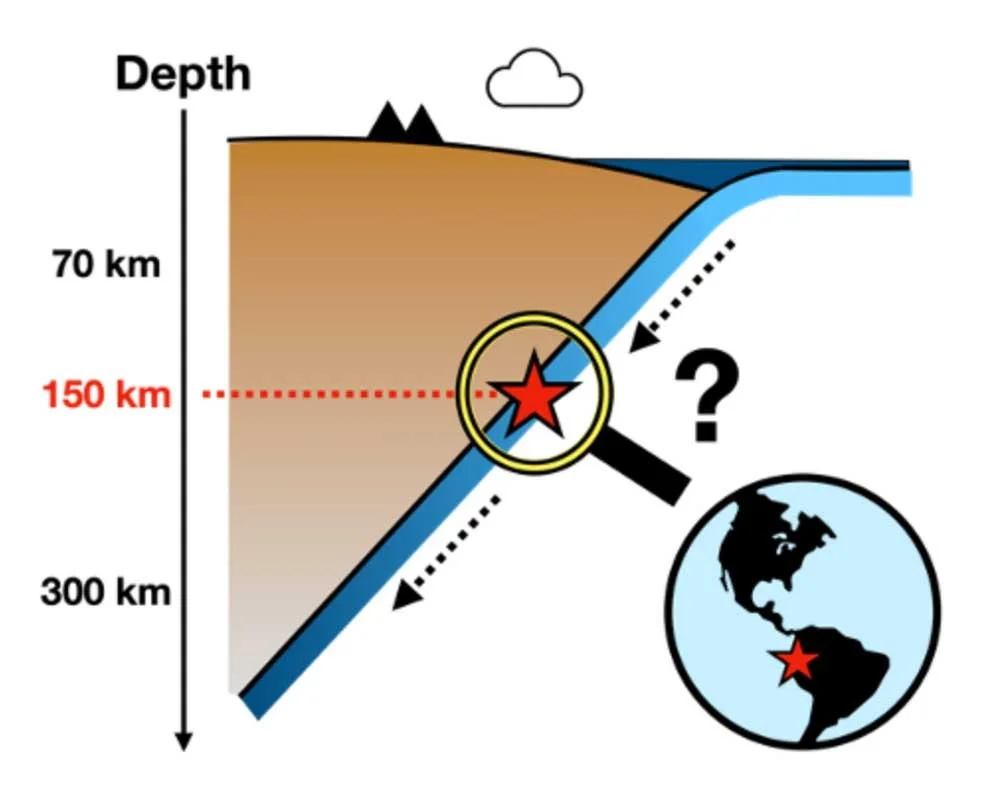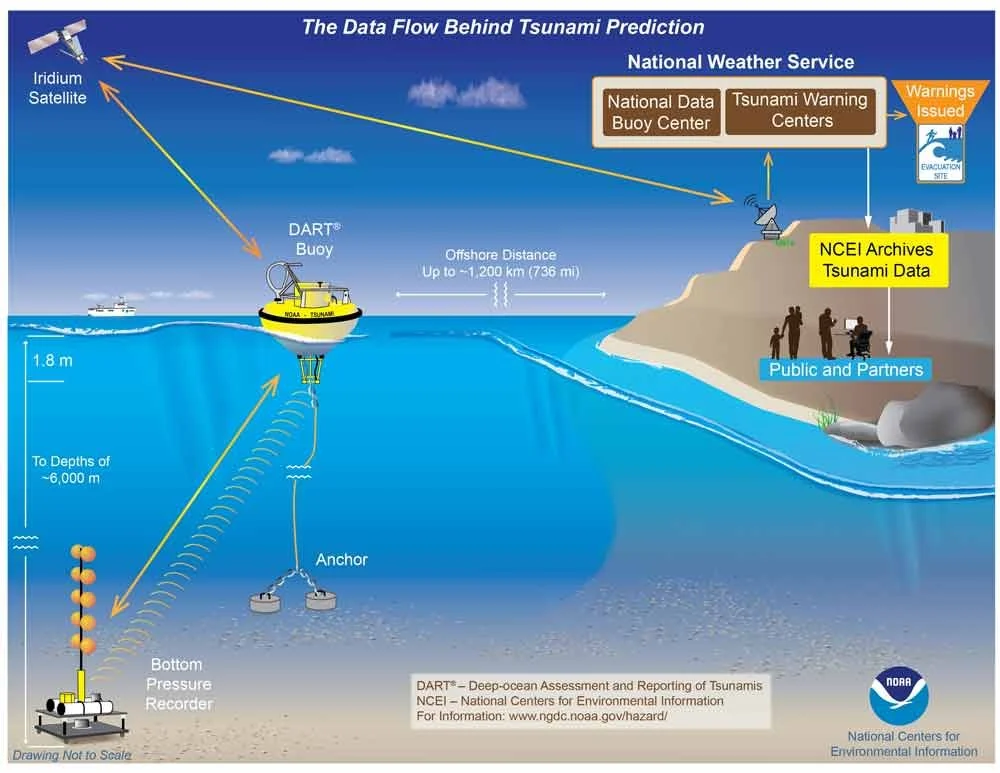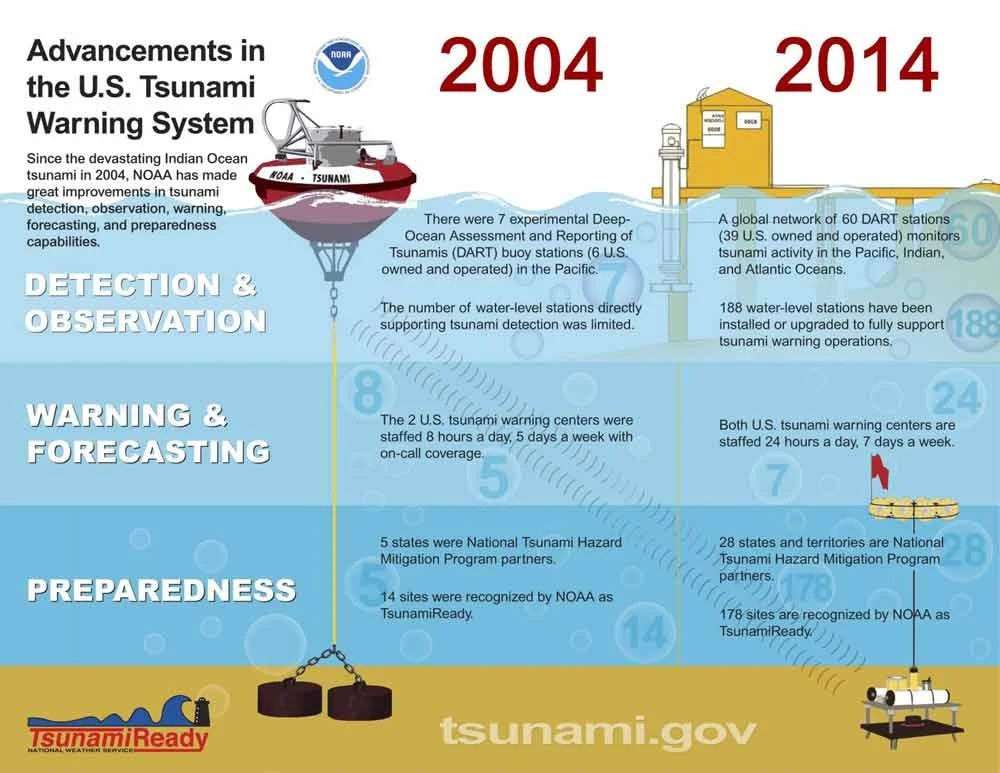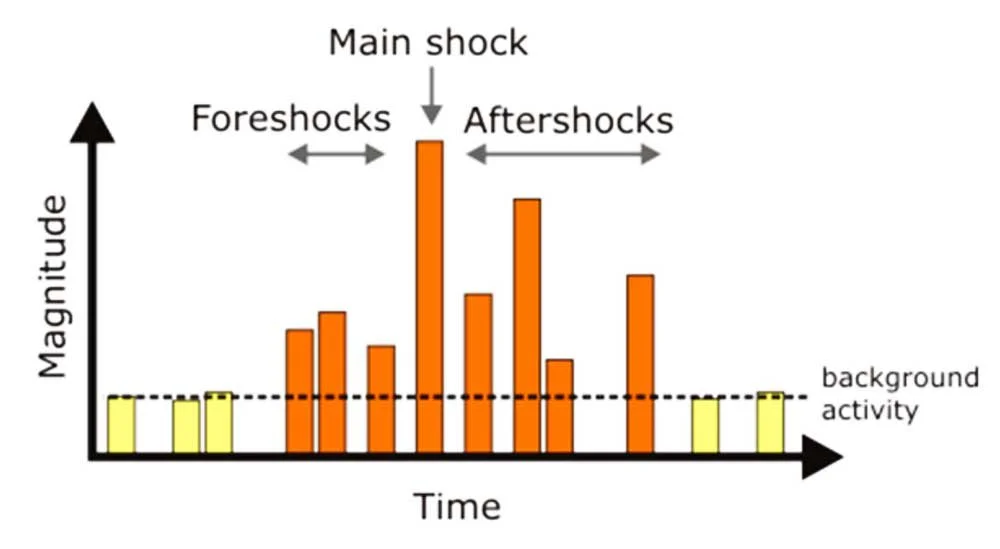The JULY 2025 Russian Mega Earthquake:
Why the Tsunami Wasn’t Worse
How powerful was the July 2025 earthquake on the Kamchatka Peninsula in Russia?
Look at the diagram of the Richter Scale. How often do earthquakes of this power occur?
What are tectonic plates?
What (and where) is the “Ring of Fire”?
Which two tectonic plates meet just off the coast of Kamchatka?
Sometimes a heavier tectonic plate slides beneath a lighter tectonic plate. What is this process called?
How do earthquakes create tsunamis?
How fast can tsunami waves move in deep water?
What happens when tsunami waves encounter shallower water?
How is it that a big earthquake — a megathrust earthquake — might not produce dangerous tsunami waves?
• Read •
The JULY 2025 Russian Mega Earthquake:
Why the Tsunami Wasn’t Worse
July 2025
In July 2025, one of the strongest earthquakes ever recorded struck eastern Russia. It measured 8.8 on the Richter scale and shook the Kamchatka Peninsula at 11:25 a.m. local time. Right away, people worried that a deadly tsunami—like the ones in Indonesia in 2004 or Japan in 2011—might be on the way.
Millions of people living near coastlines were told to move to higher ground. Everyone braced for the worst.
But something surprising happened: the tsunami wasn’t as destructive as expected. There were some waves and damage, but it wasn’t the huge disaster many feared. Why not?
Let’s take a closer look at what causes mega earthquakes, how tsunamis work, and why this one didn’t turn out to be as dangerous as others in the past.
What Makes an Earthquake So Powerful?
To understand what happened in Russia, we need to learn a bit about tectonic plates. These are giant slabs of rock that make up Earth’s outer shell. They slowly move around—sometimes bumping into each other, sometimes sliding past one another.
The Kamchatka Peninsula is part of a region known as the “Ring of Fire.” This is a huge loop of volcanoes and earthquake zones that circles the Pacific Ocean. It’s one of the most active earthquake areas on the planet.
Just off the coast of Kamchatka, two tectonic plates meet: the Pacific Plate and the Okhotsk Plate.
The Pacific Plate is made of ocean rock and is heavier than the land-based Okhotsk Plate. So, the Pacific Plate slowly slides underneath the other one. This process is called subduction.
But these plates don’t always move smoothly. Sometimes they get stuck. Pressure builds up over hundreds or even thousands of years. Then, suddenly, the pressure releases. When that happens, the Earth shakes—and sometimes it shakes really hard. That’s what causes a mega earthquake.
Scientists call this kind of earthquake a "megathrust earthquake." These are the strongest quakes ever recorded.
• Also July 2025!
In fact, a similar 9.0 earthquake hit almost the exact same spot in 1952.
What Turns an Earthquake Into a Tsunami?
Tsunamis are huge waves caused by sudden movements underwater. When a megathrust earthquake happens, it can push the ocean floor upward. That push displaces, or moves, a huge amount of water. The energy from the earthquake travels through the water as waves.
In deep water, tsunami waves move fast—over 500 miles per hour, about the speed of a passenger jet. But they are usually only about a meter high out in the open ocean. That means ships might not even notice them.
The danger happens when the waves reach shallow water near land. As they slow down, they grow taller. They can turn into towering walls of water crashing onto beaches and cities.
That’s exactly what happened during the 2004 tsunami in the Indian Ocean and again in 2011 in Japan. The water rose tens of meters high and swept far inland.
Why Wasn’t This Tsunami Worse?
This time, the tsunami that followed the Russian earthquake did cause some damage. Waves reached about 13 feet high in parts of eastern Russia. That’s definitely serious—but not nearly as bad as the disasters of 2004 or 2011.
So, what made the difference?
One reason is the shape of the seafloor and coastline.
• Ocean floor
Not all areas react the same way to incoming tsunami waves. If the land slopes gently or the seafloor is shaped a certain way, waves might not grow as tall.
Another reason is how deep the earthquake happened.
This one began about 13 miles below the surface of the Earth. That’s fairly shallow, which usually means more water gets pushed upward. But the details of how the plates moved might have kept the tsunami smaller than expected.
Some scientists think the early tsunami models may have been too cautious. If the actual earthquake happened deeper underground than they thought, the waves wouldn’t have been as large. That could explain why the damage was less than expected.
Warning Systems Save Lives
There’s another reason this event didn’t end in tragedy: people were warned early.
After the disasters of the past, many countries around the Pacific Ocean created tsunami warning systems. These systems use sensors, satellites, and alarms to tell people when to evacuate.
In 2004, no such system existed in the Indian Ocean. That’s one reason more than 230,000 people died across 14 countries. In contrast, this time, millions of people were able to move to safety before the waves arrived.
Early warning systems don’t stop earthquakes, but they do save lives.
That’s especially important because scientists still can’t predict exactly when a big earthquake will happen.
Ten days before this Russian earthquake, a smaller one—measuring 7.4—struck in the same area. That may have been a foreshock, a smaller quake that happens before a bigger one. But foreshocks don’t tell scientists exactly when the main earthquake will hit.
What Happens Next?
The shaking may not be over. After a huge earthquake, smaller quakes called aftershocks often follow.
Scientists from the Russian Academy of Sciences say they expect more aftershocks over the next month.
In the meantime, researchers will keep watching this region. They’ll study what happened, update their models, and improve their warning systems.
Each new earthquake teaches us a little more about how our planet works—and how to stay safe when it shakes.
Amplitude (n.) – the height or size of a wave.
Arc (n.) – a curved shape or path.
Coastline (n.) – where land meets the sea.
Conservative (adj.) – cautious; not extreme or risky.
Displace (v.) – to move something from its usual place.
Evacuate (v.) – to leave a place for safety.
Forecast (n.) – a prediction of what will happen in the future.
Friction (n.) – the resistance caused when things rub together.
Magnitude (n.) – a number that shows the strength of an earthquake.
Megathrust (n.) – a powerful kind of earthquake that happens when one plate slides under another.
Microplate (n.) – a small tectonic plate.
Peninsula (n.) – land almost surrounded by water but still connected to a larger landmass.
Probability (n.) – the chance that something will happen.
Seafloor (n.) – the bottom of the ocean.
Seismology (n.) – the study of earthquakes.
Shallow (adj.) – not deep.
Subduction (n.) – when one tectonic plate slides under another.
Tectonic (adj.) – related to the large plates that make up Earth’s surface.
Tsunami (n.) – a large wave caused by an earthquake or underwater explosion.
Warning (n.) – a message that tells people about danger ahead.
► COMPREHENSION QUESTIONS
— please answer with complete sentences
How powerful was the July 2025 earthquake on the Kamchatka Peninsula in Russia?
Look at the diagram of the Richter Scale. How often do earthquakes of this power occur?
What are tectonic plates?
What (and where) is the “Ring of Fire”?
Which two tectonic plates meet just off the coast of Kamchatka?
Sometimes a heavier tectonic plate slides beneath a lighter tectonic plate. What is this process called?
How do earthquakes create tsunamis?
How fast can tsunami waves move in deep water?
What happens when tsunami waves encounter shallower water?
How is it that a big earthquake — a megathrust earthquake — might not produce dangerous tsunami waves?
► From EITHER/OR ► BOTH/AND
► FROM Right/Wrong ► Creative Combination
THESIS — Argue the case that we cannot predict whether a megathrust earthquake will create dangerous tsunami waves.
ANT-THESIS — Argue the case that it is possible to predict whether a megathrust earthquake will create dangerous tsunami waves.
SYN-THESIS — How might both of these perspectives be brought together? (Perhaps focus on saving lives?)









